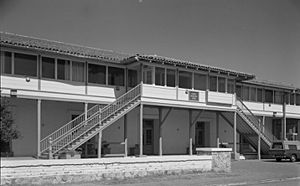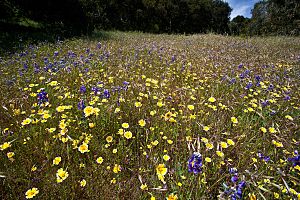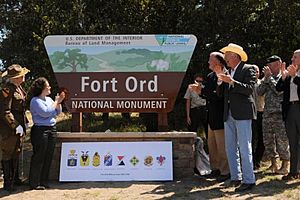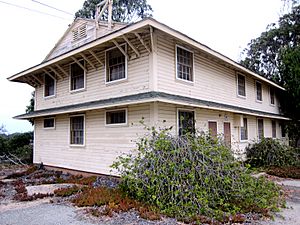Fort Ord facts for kids
Quick facts for kids Fort Ord National Monument |
|
|---|---|
| Monterey Bay area, California | |
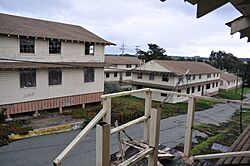
Abandoned Army barracks at Fort Ord
|
|
| Coordinates | 36°38′N 121°44′W / 36.64°N 121.74°W |
| Type | Army Post |
| Site information | |
| Controlled by | United States Army |
| Site history | |
| Built | 1917 |
| In use | 1917–1994 |
| Battles/wars | None |
| Garrison information | |
| Current commander |
None; post closed in 1994 |
Fort Ord was once a large United States Army base located on Monterey Bay in California. It was closed in 1994 as part of a program called Base Realignment and Closure (BRAC). This program helped the military save money by closing bases that were no longer needed.
Today, most of Fort Ord's land is a special protected area called the Fort Ord National Monument. The Bureau of Land Management takes care of it. A small part of the land is still used by the Army and is known as the Ord Military Community.
Before it became a fort in 1940, the land was used for military training starting in 1917. Fort Ord was known as one of the nicest Army posts. This was because it was close to the beach and had great California weather. The 7th Infantry Division was the main unit stationed there for many years.
When Fort Ord was turned over for civilian use, some land became a special nature reserve. This reserve protects the Smith's blue butterfly, which is an endangered species. Other endangered plants and animals, like the Contra Costa goldfields and the California tiger salamander, also live there.
Many old military buildings are still abandoned, but some have been taken down for new projects. Today, the area is home to California State University, Monterey Bay (CSUMB) and Fort Ord Dunes State Park. There are also new neighborhoods, a center for veterans, shops, a skydiving place, and nature areas.
On April 20, 2012, President Barack Obama officially made about 14,651 acres of the former base into the Fort Ord National Monument. He said protecting this area would keep its history alive and attract visitors. It would also help protect its unique natural beauty for everyone to enjoy.
Contents
A Look Back: Fort Ord's History
After the United States joined World War I, the Army bought land near Monterey. They used it as a training area for artillery. This area was first called the Gigling Reservation. Even though the war ended quickly in 1918, the military kept the land.
In 1933, the artillery field became Camp Ord. It was named after Major General Edward Otho Cresap Ord. At first, horse cavalry units trained there. Later, the military started using modern vehicles like tanks and armored carriers.
By 1940, Camp Ord grew to 2,000 acres. This was because World War II was happening in Europe, and the U.S. knew it might get involved. In August 1940, it was renamed Fort Ord. The 7th Infantry Division was the first big unit to move in. New training camps were built, like Camp Clayton.
In December 1941, the Imperial Japanese Navy attacked Pearl Harbor in Hawaii. This brought the U.S. into World War II. Fort Ord became a very busy place for training soldiers.
After the war ended in 1945, the Cold War began with the Soviet Union. This meant Fort Ord stayed important. In 1947, it became a training center. During the 1950s and 1960s, soldiers trained at Fort Ord before going to the Korean War. They also went to places like Japan, South Korea, and Vietnam. At one point, 50,000 troops were stationed at Fort Ord.
Between 1952 and 1954, many new buildings were constructed. This made Fort Ord a permanent Army post. Over $20 million was spent on dorms, a guard house, warehouses, and an improved water system. There were 31 dorm buildings that could house 7,000 soldiers.
In 1957, some land on the east side of the base was used to build the Laguna Seca Raceway. This race track replaced the old Pebble Beach road racing course.
Fort Ord continued to train infantry soldiers until 1976. Then, the 7th Infantry Division returned to Fort Ord after being in South Korea for 25 years.
In 1989, the U.S. Environmental Protection Agency (EPA) looked at Fort Ord. They found some environmental issues, like leaking fuel tanks and old landfills. There were also areas with unexploded bombs from training. Because of this, Fort Ord was added to a special list for cleanup in 1990.
Fort Ord Closes in 1994
In 1991, a group called the Base Realignment and Closure Commission suggested closing Fort Ord. They wanted to move the units to Fort Lewis in Washington state. On May 2, 1992, soldiers from Fort Ord helped calm the 1992 Los Angeles riots.
In 1994, Fort Ord officially closed. Most of the land was given back to California for public use. This land became the home of the new California State University, Monterey Bay (CSUMB). Some land also went to the University of California, Santa Cruz. This part became the "UC MBEST" Center, which helps with research and business in the area.
Fort Ord Reuse Authority (FORA)
The Fort Ord Reuse Authority (FORA) is in charge of helping the Monterey Bay area recover after Fort Ord closed. They also plan how to use the former base land. The military base was huge, covering about 28,000 acres.
FORA's job is to oversee how the land is used. They make sure plans are followed, remove old barriers, and help pay for new roads and buildings. They also protect important natural areas. FORA works to make sure the land is used in the best way for the community.
FORA is made up of leaders from local, state, and federal governments. It also includes people from the military and schools like CSUMB. This helps ensure that many different groups have a say in the future of Fort Ord.
Cleaning Up the Environment
The Army's Cleanup Project
The Army has been cleaning up Fort Ord since it closed. There are two main parts to this cleanup. One part deals with polluted soil and groundwater. The other part handles old bombs and explosives that might still be on the land. The Army works with the EPA and California agencies on this project.
FORA's Cleanup Project
In 2007, the Fort Ord Reuse Authority (FORA) also agreed to help clean up 3,484 acres of Fort Ord land. This means FORA is responsible for cleaning these specific areas. The Army and EPA watch over FORA's cleanup to make sure it's done correctly. The goal is to make these areas safe for people and the environment.
Fort Ord Today
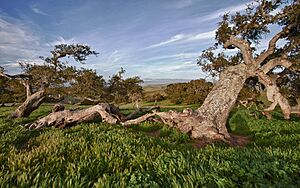
Fort Ord's former military golf courses, Bayonet and Black Horse, are now open to the public. They have even hosted professional golf events. They were updated in the mid-2010s.
California State University, Monterey Bay
California State University, Monterey Bay (CSUMB) opened on the former Fort Ord land in 1994. This was part of President Bill Clinton's plan to use old military bases for new purposes. The university now has about 6,700 students. The Leon Panetta Institute, named after a former U.S. Secretary of Defense, is also on campus. There are also housing areas for students and families connected to CSUMB and local schools.
Veterans Transition Center
The Veterans Transition Center (VTC) is also located at the old Fort Ord. It helps veterans who need a place to live and support. By 2009, the center had helped over 4,000 single veterans and many families. They were also planning to add more housing and a store to help veterans find jobs.
Fort Ord Dunes State Park and National Monument
In 2009, a strip of land along the coast became Fort Ord Dunes State Park. This area was carefully cleaned up, including removing old bombs. The Fort Ord National Monument has many entrances. There are over 91 miles of trails for walking, biking, and horseback riding. Some trails have fences because of possible unexploded bombs nearby.
On January 13, 2012, United States Secretary of the Interior Ken Salazar visited Fort Ord. He suggested to President Obama that Fort Ord should become a national monument. On April 20, 2012, President Barack Obama signed the order. This made Fort Ord a national monument.
The Fort Ord National Monument is land managed by the Bureau of Land Management (BLM). It is open to the public. The BLM currently manages 7,200 acres. They will manage 14,650 acres once the Army finishes cleaning up the rest of the land.
Remaining Military Presence
A small part of Fort Ord is still controlled by the U.S. Army. It was once called the Presidio of Monterey (POM) Annex. Now it is known as the Ord Military Community.
The military still has a presence at Fort Ord. There are California Army National Guard units and facilities managed by the Presidio of Monterey. The Defense Manpower Data Center is also there. A military grocery store, called a Commissary, is still open. It serves active duty military, reservists, National Guard members, and retired military families. Military housing is managed by private companies, but soldiers and their families still live there.
New Developments
The nearby city of Marina is building many new homes on land from the former Fort Ord. More than 1,000 new homes are planned. A large shopping center opened in late 2007 along Highway 1. The City of Marina is also planning a 13-mile recreation trail. This trail will go through Fort Ord to the Fort Ord National Monument and Fort Ord Dunes State Park.
As of December 2014, some land for a proposed project called Monterey Downs was still being cleared of old bombs. This cleanup was expected to finish by late 2017.
List of Development Projects
- City of Marina
- University Villages/Dunes on Monterey Bay
- Sea Haven
- Imjin Office Park
- Cypress Knolls (a community for older adults)
- City of Seaside
- Seaside Resort
- Main Gate Retail Center
- Central Coast Veterans Cemetery
- City of Del Rey Oaks
- Del Rey Oaks Resort (currently on hold)
- County of Monterey
- East Garrison
Interesting Facts
World War II Warhorse Hospital
The Fort Ord Station Veterinary Hospital (SVH) is located at the Marina Equestrian Center Park. It was added to the National Register of Historic Places in 2014. This hospital was built in 1941 for the Army Veterinary Corps. It cared for the 1,400 horses and mules used by the military units at Fort Ord. It is the only remaining large World War II medical facility for warhorses.
Stilwell Hall
Stilwell Hall was a huge building, about 52,000 square feet. It stood on a cliff overlooking the Pacific Ocean.
The building was built between 1940 and 1943. It was a fun place for soldiers to relax for over 50 years. After Fort Ord closed in 1994, Stilwell Hall was left empty. It started to fall apart because of coastal erosion. It was torn down in 2003 to prevent it from collapsing into the Monterey Bay National Marine Sanctuary.
Famous People Who Were at Fort Ord
Many famous people spent time at Fort Ord:
- Nick Bacon (Basic Training 1963), a Medal of Honor winner.
- Nick Bockwinkel (1958–1960), a professional wrestler.
- Paul W. Brier, a Marine Corps General, born at Fort Ord in 1959.
- Joe DiMaggio, a famous baseball player.
- Clint Eastwood, an actor and director, was a lifeguard there. He later became a mayor in nearby Carmel.
- Herm Edwards, an NFL player and coach.
- Jamie Farr, an actor.
- Jerry Garcia, musician and co-founder of the Grateful Dead.
- Jimi Hendrix, musician, was there for basic training in 1961.
- David Janssen, an actor.
- James Lofton, a professional football player, born at Fort Ord in 1956.
- Ollie Matson, a Pro Football Hall of Fame player and Olympic medalist.
- Martin Milner, an actor.
- Harold G. Moore, an author and Army General.
- Matthew Morrison, an actor and singer.
- Leonard Nimoy, an actor and director, known as Spock from Star Trek.
- Raymond T. Odierno, a former Army Chief of Staff.
- Alan Osmond, a singer and leader of The Osmonds.
- Ken Osmond, an actor.
- Steve Owens, a Heisman Trophy winner.
- Ron Rivera, an NFL head coach.
- John Saxon, an actor.
- Joseph Stilwell, a World War II general.
- Jan-Michael Vincent, an actor.
Fort Ord in Movies and TV
Fort Ord has been featured in several films and TV shows:
- The 1951 film The Lady Says No was filmed at Fort Ord.
- The 1956 film The Girl He Left Behind was filmed at Fort Ord.
- The 1963 film Soldier in the Rain was also filmed at Fort Ord.
- The 1980 film Private Benjamin showed a photo of yachts at Fort Ord in a recruitment scene.
- The TV series MythBusters often used the abandoned streets of Fort Ord for car tests.
- Fort Ord is the setting for Dave Egger's 2014 novel Your Fathers, Where Are They?.
Images for kids






